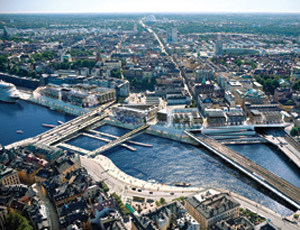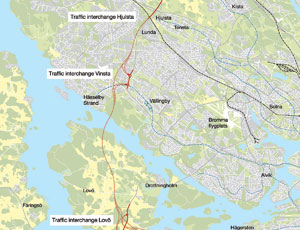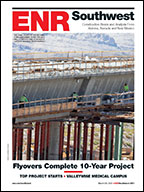A $4-billion-plus highway that includes what will be one of the world’s longest highway tunnels will soon be under construction along the west side of Stockholm, Sweden.

Sited next to the popular tourist haunt Gamla Stan (Old Town), a smaller project to remodel the central Slussen area may grab more public attention.
Both projects are proceeding at a neck-and-neck pace toward the start of construction.
Given approval by the Swedish government, “we [believe] we can start with construction in 2012,” says Anna Nylén, a project manager for the Swedish Road Administration (V�gverket) on the 21-kilometer E4/E20 Stockholm Bypass Project. The administration estimates construction will take eight years to complete.
The city is now in its last public consultation phase on the Slussen job, which is slated for a 2012 start.
The $120-million Slussen project aims to solve a nagging problem by replacing the unsightly array of aging bridge structures that runs between the northern historic Gamla Stan area and the Södermalm district.
The bridge structures spread over 40,000 sq meters and include two bridge crossings. Below the bridges lies a ship navigation lock between, to the west, the freshwater Lake M�laren and, to the east, the Baltic Sea.
City engineers paint a grim picture of the 75-year-old bridges, citing degraded concrete substructures and decks as well as unsound foundations. About half the structures are founded on pressure-injected footings, known in Europe as Franki piles, and the remainder are on slabs or timber piles. The Franki piles show signs of faulty construction, and engineers report settlements of up to 25 centimeters.
Maintenance crews have been “patching and mending” since the 1980s, says the city’s project director, M�rten Frumerie. “There is a large risk of flooding in the lake and around the shore,” Frumerie says. “We have to get more water out of the lake and into the Baltic sea.”
The city of Stockholm has run two master-plan competitions to remodel Slussen, reduce the extent and bulk of its bridges, and improve the area’s attractiveness. It chose last year a scheme by Foster + Partners, London, with Stockholm-based Berg Arkitektkontor. The plan was revised following public consultation, and Frumerie hopes the definitive version will be approved by spring.
Last month, the city appointed the local team of design firms Grontmij Sweden with Hifab A.B. to manage the project’s development. “We have to make sure the Foster plan is possible to build,” says Leif Bertilsson, local chief executive officer for Grontmij.
The team will manage firms responsible for detail designs. Those firms could be recruited by early 2011. Bertilsson believes competition will come from outside Sweden. “This is such a complicated project,” he says.
The job’s complexity is partly due to its congested central site, Frumerie says.
By contrast, the 21-km bypass will be almost entirely belowground.
Some 17 km of the 21-km road will be in twin tunnels. While the project will be among the world’s longest road tunnels, it will be about 7.5 km shorter than another such road tunnel, Norway’s Laerdal mountain crossing, completed in 2000.
The new E4/E20 Stockholm Bypass Project will skirt the west side of the city between Kungens Kurva and H�ggvik, about 12 km east of Slussen. It is designed to relieve traffic congestion around the more central Essingeleden viaduct, which carries twice its 160,000 vehicle-per-day design, according to the road administration.
In September, the administration selected three design teams, all led by Stockholm-based firms, for four assignments covering most of the project. By year’s end, the administration aims to approve the two-year design contracts that are worth, in total, around $44.9 million.
ÅF Infrastruktur A.B., Stockholm, in collaboration with URS-Scott Wilson Ltd., London, was awarded two of the four assignments. Grontmij in a joint venture with Golder Associates, Calgary, won one contract. The other went to a team of Sweco Infrastructure A.B., Stockholm, with the local unit of WSP Group, London, and Tyréns A.B., Stockholm.
Site investigation has started along the route.





Post a comment to this article
Report Abusive Comment